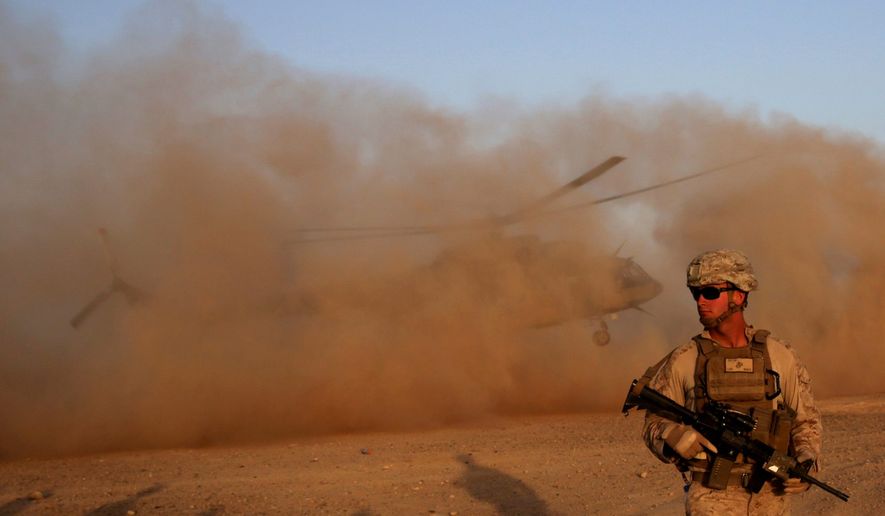The Pentagon for the first time revealed Tuesday that nearly 11,000 American troops are still on the ground in Afghanistan, roughly 40 percent more than what Defense Department leaders had acknowledged since President Obama ended the U.S. combat mission three years earlier.
The revised troop figures, announced by the Pentagon on Monday, were the result of a new method of accounting for U.S. soldiers, sailors, airmen and Marines serving in Afghanistan, Pentagon press secretary Dana White said Monday. Defense Secretary James Mattis ordered the department to adopt the new troop-counting method, as part of the Pentagon’s review of its operations in Afghanistan and South Asia.
The larger number, which comes as President Trump has authorized sending even more U.S. forces into the 16-year-long war, means the U.S. could have as many as 15,000 troops deployed in Afghanistan within the next few months, despite the doubts then-candidate Trump raised about the mission on the campaign trail in 2016.
The upwardly revised tally takes into account troops temporarily assigned to forward units in Afghanistan, service members in “combat support agencies” and those supporting operations for the NATO-led military adviser mission, said Joint Staff Director Lt. Gen. Kenneth McKenzie.
That formula adds 2,600 troops to the current roster of American forces in Afghanistan, and for the first time includes U.S. troops involved in direct counterterrorism missions under Operation Freedom’s Sentinel.
“That’s the number that you’ll get from the department from now on,” Gen. McKenzie told reporters at the Pentagon.
Identifying the actual number of U.S. service members was an effort by Mr. Mattis to get away from the Obama-era troop caps in Afghanistan, known inside the Pentagon as “forces management levels” and provide a clearer picture of America’s military commitment, Ms. White noted.
Pentagon officials are currently working on similar metrics on U.S. troop levels in the fight against Islamic State in Iraq and Syria, Ms. White noted.
Currently, the Pentagon counts roughly 5,500 American troops on the ground in Iraq and Syria, but officials say privately the more accurate figure may be as much as 3,000 troops higher.
While the Pentagon claims the release of its revised force levels in Afghanistan is an attempt at greater transparency, the new numbers could be clearing a final hurdle for a pending troops surge into Afghanistan.
The White House earlier this year announced that setting troop levels for Afghanistan, as well as Washington’s war against the Islamic State in Iraq and Syria, would fall to the Pentagon chief. Mr. Mattis, along with National Security Adviser H.R. McMaster are looking to add another 3,900 American troops into Afghanistan.
Earlier this month, Mr. Mattis told reporters that he wanted to have a firm grasp of the full extent of U.S. military involvement in Afghanistan before signing off on a troop increase. The White House plans a briefing for every member of the Senate next Wednesday on the Afghan fight when Congress returns to town, Politico reported.
On Monday, Ms. White said that the revised troop numbers for Afghanistan did not necessarily mean a decision on a troop surge was imminent. “When we have something to announce, we’ll let you know,” she said.
Gen. McKenzie also denied reports that combat commanders in the region were already poised to funnel fresh troops into Afghanistan as part of the White House’s new war plan. When asked if those deployments had begun, the three-star general replied: “No decision’s been made by the secretary. No deployment orders have been issued.”
Last week, U.S. Central Command Chief Gen. Joseph Votel said the first tranche of new American troops will begin arriving in country within weeks. At the time, the four-star general said the deployments could begin “pretty quickly” in order to maximize the effect those forces would have against the Taliban this year.
“What’s most important for us now is to get some capabilities in to have an impact on the current fighting season,” Gen. Votel told The Associated Press last week.
Mr. Trump unveiled his new Afghan war plan nearly a week ago. He did not explicitly call for a troop increase during his prime time televised speech, but he did announce plans to abandon the timeline-based approach to the American mission in Afghanistan, in favor of a “conditions-based” strategy.
Administration critics claim the decision will effectively restart U.S.-led combat operations in Afghanistan, which officially ended in late 2014, and force Washington into an open-ended conflict.
• Carlo Muñoz can be reached at cmunoz@washingtontimes.com.




Please read our comment policy before commenting.